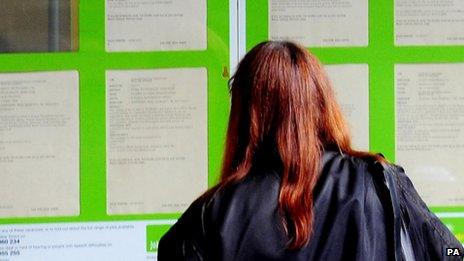UK unemployment falls by 63,000 to 2.33 million
- Published

The number of people out of work in the UK fell by 63,000 to 2.33 million in the three months to January 2014, according to official figures.
The unemployment rate now stands at 7.2% of the population, the Office for National Statistics, external (ONS) said.
The number of people in employment rose to a record 30.19 million, helped by a rise in the number of self-employed.
Average earnings also increased, with pay in the three months to January up 1.4% from a year earlier.
The number of employees in work fell by 60,000, but 211,000 more people were recorded as self-employed.
Esther McVey said the figures are going in the right direction
There was better news for young people, as the number of unemployed 16 to 24-year-olds stood at 912,000 in the three months to January, a drop of 29,000 and the lowest level since 2011.
In February, the number of people claiming Jobseeker's Allowance fell by 34,600 to 1.175 million. Over the course of a year, the number has dropped by 363,200.
'Improving economy'
Employment Minister Esther McVey said the overall fall in unemployment showed that "the growing economy is helping record numbers of people to find a job".
"The rise in employment is being fuelled by businesses and entrepreneurs across the country who are feeling increasingly confident with the improving economy," she added.
Prime Minister David Cameron tweeted: "Another significant fall in unemployment is a sign our long-term economic plan is working, providing security and chances for hard-working people."
But shadow work and pensions secretary Rachel Reeves disagreed, saying "long-term youth unemployment has doubled under David Cameron".
"It's clear tens of thousands of young people are not feeling any recovery at all," she said.

The North East has the highest rate of unemployment in the UK at 9.5%
"Today's figures also show that working people facing a cost-of-living crisis and that prices are still rising faster than wages under David Cameron."
Spending support
David Tinsley, an economist at BNP Paribas, said that while the employment figures were promising, there were some weak areas, pointing out that the rise in employment was down to the increase in the number of self-employed.
Rachel Reeves welcomed the fall, but said there were still areas of concern
He also noted that the average weekly hours worked by full-time UK employees was down by 0.2%.
However, Mr Tinsley added: "The pick-up in earnings growth and a decent rise in employment, alongside falling inflation, means the prospects for real income growth are looking better. That in turn can help support a more sustainable rise in consumer spending this year.
David Kern, chief economist at the British Chambers of Commerce, said that while youth unemployment had gone down, the rate was "still nearly three times the rate of unemployment as a whole".
Earnings "remain below inflation", he added.
Regional variation
The North East of England has the highest unemployment rate in the UK, at 9.5%. In the South East, where the rate is lowest, only 5.2% are out of work.
The unemployment rate in Scotland fell to 6.9%, in Wales it was 6.7% while in Northern Ireland it was 7.5%.
Just over 10% more men are employed than women in the UK, but the unemployment rate for men was higher than for women, with 7.4% of the male labour force out of work.
There were 159,000 fewer people employed in the public sector in December 2013, compared with the September figure. However, a large part of this reduction was due to the privatisation of Royal Mail.
The figures for unemployment in the three months to January are based on the Labour Force Survey, in which the ONS speaks to 60,000 households once a quarter, making it the country's biggest household survey.
The ONS is 95% confident that the unemployment figure is correct to plus or minus 81,000 people.
Recovery 'broadening'
Separately, the Bank of England released the minutes from the latest meeting of its Monetary Policy Committee., external
The minutes showed that all nine MPC members voted earlier this month to keep interest rates at 0.5% and to keep the programme of quantitative easing unchanged at £375bn, as expected.
The MPC noted the recovery in the UK economy was widening beyond consumer spending.
"There were initial signs that the anticipated broadening from household to business spending might have already begun," the minutes said.
"Even so, there remained some way to go to ensure that the recovery was both balanced and sustainable."